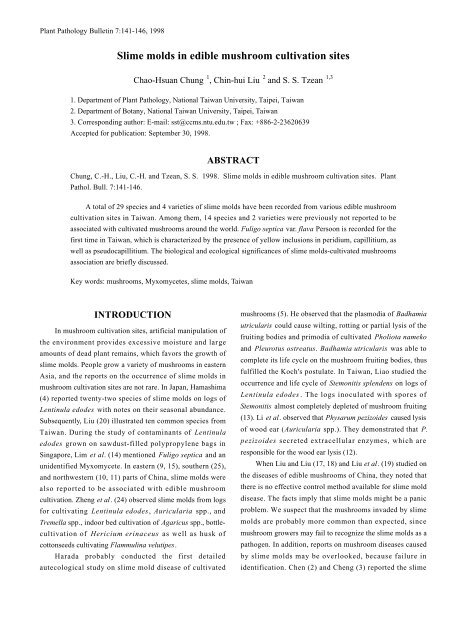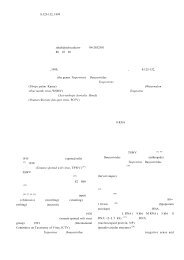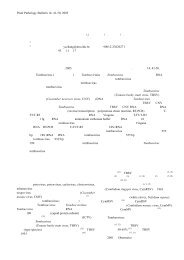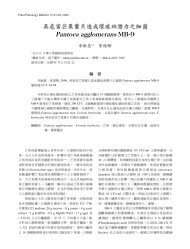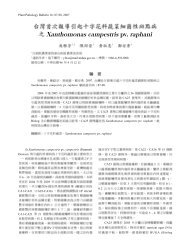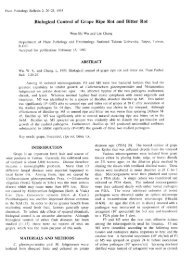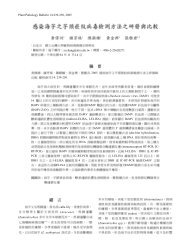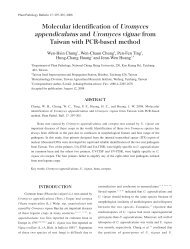Slime molds in edible mushroom cultivation sites
Slime molds in edible mushroom cultivation sites
Slime molds in edible mushroom cultivation sites
Create successful ePaper yourself
Turn your PDF publications into a flip-book with our unique Google optimized e-Paper software.
Plant Pathology Bullet<strong>in</strong> 7:141-146, 1998<strong>Slime</strong> <strong>molds</strong> <strong>in</strong> <strong>edible</strong> <strong>mushroom</strong> <strong>cultivation</strong> <strong>sites</strong>Chao-Hsuan Chung 1 , Ch<strong>in</strong>-hui Liu 2 and S. S. Tzean 1 , 31. Department of Plant Pathology, National Taiwan University, Taipei, Ta i w a n2. Department of Botany, National Taiwan University, Taipei, Ta i w a n3. Correspond<strong>in</strong>g author: E-mail: sst@ccms.ntu.edu.tw ; Fax: +886-2-23620639Accepted for publication: September 30, 1998.A B S T R A C TChung, C.-H., Liu, C.-H. and Tzean, S. S. 1998. <strong>Slime</strong> <strong>molds</strong> <strong>in</strong> <strong>edible</strong> <strong>mushroom</strong> <strong>cultivation</strong> <strong>sites</strong>. PlantPathol. Bull. 7:141-146.A total of 29 species and 4 varieties of slime <strong>molds</strong> have been recorded from various <strong>edible</strong> <strong>mushroom</strong><strong>cultivation</strong> <strong>sites</strong> <strong>in</strong> Taiwan. Among them, 14 species and 2 varieties were previously not reported to beassociated with cultivated <strong>mushroom</strong>s around the world. Fuligo septica v a r. f l a v a Persoon is recorded for thefirst time <strong>in</strong> Taiwan, which is characterized by the presence of yellow <strong>in</strong>clusions <strong>in</strong> peridium, capillitium, aswell as pseudocapillitium. The biological and ecological significances of slime <strong>molds</strong>-cultivated <strong>mushroom</strong>sassociation are briefly discussed.Key words: <strong>mushroom</strong>s, Myxomycetes, slime <strong>molds</strong>, Ta i w a nI N T R O D U C T I O NIn <strong>mushroom</strong> <strong>cultivation</strong> <strong>sites</strong>, artificial manipulation ofthe environment provides excessive moisture and larg eamounts of dead plant rema<strong>in</strong>s, which favors the growth ofslime <strong>molds</strong>. People grow a variety of <strong>mushroom</strong>s <strong>in</strong> easternAsia, and the reports on the occurrence of slime <strong>molds</strong> <strong>in</strong><strong>mushroom</strong> <strong>cultivation</strong> <strong>sites</strong> are not rare. In Japan, Hamashima(4) reported twenty-two species of slime <strong>molds</strong> on logs ofLent<strong>in</strong>ula edodes with notes on their seasonal abundance.S u b s e q u e n t l y, Liu (20) illustrated ten common species fromTaiwan. Dur<strong>in</strong>g the study of contam<strong>in</strong>ants of L e n t i n u l ae d o d e s grown on sawdust-filled polypropylene bags <strong>in</strong>S<strong>in</strong>gapore, Lim et al. (14) mentioned Fuligo septica and anunidentified Myxomycete. In eastern (9, 15), southern (25),and northwestern (10, 11) parts of Ch<strong>in</strong>a, slime <strong>molds</strong> werealso reported to be associated with <strong>edible</strong> <strong>mushroom</strong><strong>cultivation</strong>. Zheng et al. (24) observed slime <strong>molds</strong> from logsfor cultivat<strong>in</strong>g Lent<strong>in</strong>ula edodes, Auricularia spp., andTremella spp., <strong>in</strong>door bed <strong>cultivation</strong> of A g a r i c u s spp., bottle<strong>cultivation</strong>of Hericium er<strong>in</strong>aceus as well as husk ofcottonseeds cultivat<strong>in</strong>g Flammul<strong>in</strong>a velutipes.Harada probably conducted the first detailedautecological study on slime mold disease of cultivated<strong>mushroom</strong>s (5). He observed that the plasmodia of B a d h a m i au t r i c u l a r i s could cause wilt<strong>in</strong>g, rott<strong>in</strong>g or partial lysis of thefruit<strong>in</strong>g bodies and primodia of cultivated Pholiota namekoand P l e u rotus ostre a t u s. Badhamia utricularis was able tocomplete its life cycle on the <strong>mushroom</strong> fruit<strong>in</strong>g bodies, thusfulfilled the Koch's postulate. In Taiwan, Liao studied theoccurrence and life cycle of Stemonitis splendens on logs ofLent<strong>in</strong>ula edodes. The logs <strong>in</strong>oculated with spores ofS t e m o n i t i s almost completely depleted of <strong>mushroom</strong> fruit<strong>in</strong>g(13). Li et al. observed that P h y s a rum pezizoides caused lysisof wood ear (A u r i c u l a r i a spp.). They demonstrated that P.p e z i z o i d e s secreted extracellular enzymes, which areresponsible for the wood ear lysis (12).When Liu and Liu (17, 18) and Liu et al. (19) studied onthe diseases of <strong>edible</strong> <strong>mushroom</strong>s of Ch<strong>in</strong>a, they noted thatthere is no effective control method available for slime molddisease. The facts imply that slime <strong>molds</strong> might be a panicproblem. We suspect that the <strong>mushroom</strong>s <strong>in</strong>vaded by slime<strong>molds</strong> are probably more common than expected, s<strong>in</strong>ce<strong>mushroom</strong> growers may fail to recognize the slime <strong>molds</strong> as apathogen. In addition, reports on <strong>mushroom</strong> diseases causedby slime <strong>molds</strong> may be overlooked, because failure <strong>in</strong>identification. Chen (2) and Cheng (3) reported the slime
1 4 2Plant Pathology Bullet<strong>in</strong> Vol.7(3) 1998mold disease of cultivated G a n o d e r m a and A u r i c u l a r i a i nTaiwan, respectively, and both of them failed to identify thecasual organisms. Lim et al. also listed an unidentifiedMyxomycete, as mentioned above (14). We are also unawareof any attempt <strong>in</strong> any scale to estimate the degree of damagecaused by the slime <strong>molds</strong>. In order to facilitate theunderstand<strong>in</strong>g of the slime <strong>molds</strong>-<strong>edible</strong> <strong>mushroom</strong>sassociation, we summerize our prelim<strong>in</strong>ary observations onthe biodiversity of slime <strong>molds</strong> associated with <strong>edible</strong><strong>mushroom</strong> <strong>cultivation</strong> <strong>in</strong> this communication.M ATERIALS AND METHODSThe specimens of slime <strong>molds</strong> collected from <strong>mushroom</strong><strong>cultivation</strong> <strong>sites</strong> were deposited <strong>in</strong> the Mycology Laboratory,Department of Botany, National Taiwan University and be<strong>in</strong>gexam<strong>in</strong>ed <strong>in</strong> this study. In addition, one of us (Chung) hassurveyed several <strong>mushroom</strong> <strong>cultivation</strong> <strong>sites</strong> <strong>in</strong> northernTaiwan dur<strong>in</strong>g 1995-1997 to collect additional specimens anddata. The identification and classification system of slime<strong>molds</strong> was adopted from Mart<strong>in</strong> and Alexopoulos (21) andrelated references.R E S U LT SA total of twenty-n<strong>in</strong>e species and four varieties of slime<strong>molds</strong> from <strong>mushroom</strong> <strong>cultivation</strong> <strong>sites</strong> <strong>in</strong> Taiwan are listedb e l o w. For each adm<strong>in</strong>istrative area a voucher specimen isselected and cited, and taxa are arranged alphabetically with<strong>in</strong>each order. Accord<strong>in</strong>g to literature records (4, 5, 9-15, 17-20,24, 25), fourteen species and two varieties (marked with anasterisk) are not known from <strong>edible</strong> <strong>mushroom</strong> <strong>cultivation</strong><strong>sites</strong> around the world. Species marked with double asteriskshad been proved to be pathogenic to cultivated <strong>mushroom</strong>s( 13 ).C E R AT I O M Y X A L E SCeratiomyxa fru t i c u l o s a (Mueller) T. MacbrideSpecimen exam<strong>in</strong>ed: Ta<strong>in</strong>an City, Aug. 4, 1986, on deadwood, Liu CHLB618.L I C E A L E S*Dictydiaethalium plumbeum (Schumacher) Rostaf<strong>in</strong>skiSpecimen exam<strong>in</strong>ed: Nantou County, Nov. 14, 1983, ondead wood, Liu CHLB327; Ta<strong>in</strong>an City, Aug. 4, 1986, ondead wood, Liu CHLB602.Lycogala conicum P e r s o o nSpecimen exam<strong>in</strong>ed: Taipei County, s. d., on dead wood,Liu CHLM188; Nantou County, Oct. 26, 1981, on dead wood,Liu CHLM380.Lycogala epidendru m (L.) FriesSpecimen exam<strong>in</strong>ed: Ta<strong>in</strong>an City, Oct. 4, 1986, on deadwood, Liu CHLB616.*Reticularia lycoperd o n B u l l i a r dSpecimen exam<strong>in</strong>ed: Hs<strong>in</strong>chu County, Feb. 11, 1981, ondead wood, Liu 193.T R I C H I A L E SA rcyria c<strong>in</strong>ere a (Bulliard) PersoonSpecimen exam<strong>in</strong>ed: Taipei County, Dec. 12, 1978, ondead wood, Liu CHLM1; Nantou County, Nov. 26, 1979, ondead wood, Liu CHLM32.A rcyria denudata (L.) We t t s t e i nSpecimen exam<strong>in</strong>ed: Taipei County, Nov. 12, 1978, ondead wood, Liu CHLM3; Nantou County, Nov. 25, 1979, ondead wood, Liu CHLM42; Ta<strong>in</strong>an City, Jun. 28, 1981, ondead wood, Liu CHLM362.A rcyria <strong>in</strong>carnata (Persoon) PersoonSpecimen exam<strong>in</strong>ed: Nantou County, Oct. 26, 1981, ondead wood, Liu CHLM382; Ta<strong>in</strong>an City, Aug. 4, 1986, ondead wood, Liu CHLB617.*Hemitrichia clavata v a r. c a l y c u l a t a (Spegazz<strong>in</strong>i) Y.Ya m a m o t oSpecimen exam<strong>in</strong>ed: Taipei County, Mar. 16, 1988, ondead wood, Liu CHLB794; Nantou County, Sep. 16, 1980, ondead wood, Liu CHLM150.Hemitrichia serpula (Scopoli) Rostaf<strong>in</strong>skiSpecimen exam<strong>in</strong>ed: Nantou County, Oct. 26, 1981, ondead wood, Liu CHLM388.*Metatrichia vesparium (Batsch) Nannenga-BremekampSpecimen exam<strong>in</strong>ed: Nantou County, Nov. 26, 1979, ondead wood, Liu CHLM33.Trichia favog<strong>in</strong>ea (Batsch) Persoon s. l.Specimen exam<strong>in</strong>ed: Nantou County, Nov. 26, 1979, ondead wood, Liu CHLM34.*Trichia scabra Rostaf<strong>in</strong>skiSpecimen exam<strong>in</strong>ed: Nantou County, Oct. 26, 1981, ondead wood, Liu CHLM392.P H Y S A R A L E S*Didymium clavus (Albert<strong>in</strong>i & Schwe<strong>in</strong>itz) RabenhorstSpecimen exam<strong>in</strong>ed: Ta<strong>in</strong>an City, Aug. 4, 1986, on deadwood, Liu CHLB612.
<strong>Slime</strong> <strong>molds</strong> <strong>in</strong> <strong>edible</strong> <strong>mushroom</strong> <strong>cultivation</strong> <strong>sites</strong> 1 4 3*Didymium iridis (Ditmar) FriesSpecimen exam<strong>in</strong>ed: Ta<strong>in</strong>an City, Aug. 4, 1986, on deadwood, Liu CHLB611 .*Didymium squamulosum (Albert<strong>in</strong>i & Schwe<strong>in</strong>itz) FriesSpecimen exam<strong>in</strong>ed: Ta<strong>in</strong>an City, Aug. 4, 1986, on deadwood, Liu CHLB613.Fuligo septica (L.) Wiggers var. s e p t i c aSpecimen exam<strong>in</strong>ed: Ta<strong>in</strong>an City, Aug. 4, 1986, onplastics, Liu CHLB608.*Fuligo septica v a r. f l a v a Persoon, Roemers Neues Mag.Bot. 1: 88. 1794. Figs 1-4.Specimen exam<strong>in</strong>ed: Ta<strong>in</strong>an City, Aug. 4, 1986, on deadwood, Liu CHLB614.Notes: New to Taiwan. The variety is characterized bythe presence of yellow <strong>in</strong>clusions <strong>in</strong> peridium, capillitium, aswell as pseudocapillitium. Some additional records of thisvariety <strong>in</strong> Taiwan are given below.Additional specimens exam<strong>in</strong>ed (not from <strong>mushroom</strong>Figs 1-4. Fuligo septica v a r. f l a v a. Fig. 1. Yellow <strong>in</strong>clusions (arrows) <strong>in</strong> pseudocapillitium under light microscope (LM),about 1,000X; Fig. 2. Yellow <strong>in</strong>clusions (arrow) <strong>in</strong> capillitium (Cp), LM, about 1,100X; Figs 3, 4. Yellow <strong>in</strong>clusions (arrows) <strong>in</strong>peridium under scann<strong>in</strong>g electron microscopy, bar <strong>in</strong> Fig. 3 = 10m, bar <strong>in</strong> Fig. 4. = 2m. C: granular calcium deposition; S:s p o r e s .
1 4 4Plant Pathology Bullet<strong>in</strong> Vol.7(3) 1998<strong>cultivation</strong> <strong>sites</strong>): Taipei Metropolis, Ma<strong>in</strong> campus of theNational Taiwan University, 12 V 1993, on bark of M e l a l e u c al e u c a d e n d r a, W. C. Leong 11; d i t t o except collected 22 VII1996, C.-H. Chung M1294; 15 VI 1993, on dead bark ofC ryptomeria japonica, C. P. Chang 19; Taipei County,between Shihmen and K<strong>in</strong>shan, 28 X 1995, on dead woodalong the seashore, C.-H. Chung M922.P h y s a rum nutans P e r s o o nSpecimen exam<strong>in</strong>ed: Nantou County, Apr. 8, 1981, ondead wood, Liu CHLM285.P h y s a rum rigidum (G. Lister) G. ListerSpecimen exam<strong>in</strong>ed: Hs<strong>in</strong>chu County, Nov. 30, 1980, onplastic bags used for cultivat<strong>in</strong>g A u r i c u l a r i a, Liu CHLM52;Nantou County, Apr. 8, 1981, on dead wood, Liu CHLM310.*P h y s a rum viride (Bulliard) PersoonSpecimen exam<strong>in</strong>ed: Nantou County, Apr. 8, 1981, ondead wood, Liu CHLM289.S T E M O N I TA L E SCollaria ar c y r i o n e m a (Rostaf<strong>in</strong>ski) Nannenga-Bremekamp e x L a d oSpecimen exam<strong>in</strong>ed: Hs<strong>in</strong>chu County, Sep. 4, 1980, ondead wood, Liu CHLM107.Stemonaria longa (Peck) Nannenga-Bremekamp, R.Sharma & Y. Ya m a m o t oSpecimen exam<strong>in</strong>ed: Taipei County, Feb. 26, 1980, ondead wood, Liu CHLM80; Nantou County, Sep. 15, 1980, ondead wood, Liu CHLM128; Ta<strong>in</strong>an City, Aug. 4, 1986, ondead wood, Liu CHLB603.S t e m o n i t i s a x i f e r a (Bulliard) T. Macbride var. a x i f e r aSpecimen exam<strong>in</strong>ed: Nantou County, Apr. 8, 1981, ondead wood, Liu CHLM348.*S t e m o n i t i s a x i f e r a v a r. s m i t h i i ( T. Macbride) Hagelste<strong>in</strong>Specimen exam<strong>in</strong>ed: Taipei Metropolis, Mar. 16, 1988,on dead wood, Liu CHLB790a; Taipei County, Oct. 18, 1984,on dead wood, Liu CHLB425; Hs<strong>in</strong>chu County, Sep. 4, 1980,on dead wood, Liu CHLM108.S t e m o n i t i s f u s c a Roth var. f u s c aSpecimen exam<strong>in</strong>ed: Nantou County, Oct. 26, 1981, ondead wood, Liu CHLM386; Ta<strong>in</strong>an City, Aug. 4, 1986, ondead wood, Liu CHLB621.*S t e m o n i t i s f u s c a v a r. n i g re s c e n s (Rex) To r r e n dSpecimen exam<strong>in</strong>ed: Hs<strong>in</strong>chu County, Feb. 11, 1981, ondead wood, Liu CHLM192; Nantou County, Apr. 7, 1981, ondead bark, Liu CHLM209; Ta<strong>in</strong>an City, Aug. 4, 1986, deadwood, Liu CHLB619.*S t e m o n i t i s f u s c a v a r. p a p i l l o s a M e y l a nSpecimen exam<strong>in</strong>ed: Nantou County, Nov. 19, 1980, ondead wood, Liu CHLM167.S t e m o n i t i s h e r b a t i c a P e c kSpecimen exam<strong>in</strong>ed: Taipei County, Oct. 18, 1984, ondead wood, Liu CHLB424; Hs<strong>in</strong>chu County, Jun. 11, 1980,on plant debris, Liu CHLM75; Nantou County, Nov. 19, 1980,on dead wood, Liu CHLM77.**Stemonitis splendens R o s t a f i n s k iSpecimen exam<strong>in</strong>ed: Taipei Metropolis, Mar. 16, 1988,on dead bark, Liu CHLB786; Hs<strong>in</strong>chu County, Sep. 15, 1980,on dead wood, Liu CHLM124; Nantou County, Nov. 14,1983, on dead wood, Liu CHLB339.Notes: Liao (13) has reported this species as pathogenicto Lent<strong>in</strong>ula edodes.*S t e m o n i t i s v i rg i n i e n s i s R e xSpecimen exam<strong>in</strong>ed: Hs<strong>in</strong>chu County, Sep. 4, 1980, ondead wood, Liu CHLM106.*Stemonitopsis hypero p t a (Meylan) Nannenga-B r e m e k a m pSpecimen exam<strong>in</strong>ed: Taipei Metropolis, Mar. 16, 1988,on dead wood, Liu CHLB790b; Nantou County, Nov. 14,1983, on dead wood, Liu CHLM337.*Stemonitopsis typh<strong>in</strong>a ( Wiggers) Nannenga-B r e m e k a m pSpecimen exam<strong>in</strong>ed: Taipei County, Oct. 18, 1984, ondead bark, Liu CHLB422.D I S C U S S I O NTrue slime <strong>molds</strong> are well known to be culturedaxenically for experimental biology <strong>in</strong> recent decades, butHoward (6) and Lister (16) have raised these organisms byfresh <strong>mushroom</strong>s <strong>in</strong> earlier times. Howard and Currie (8) andHoward (7) made scrut<strong>in</strong>ous observations and sophisticatedexperiments on the mycophagy of slime <strong>molds</strong>. A total oftwenty-three mycophagous taxa were proposed by them, ofwhich eleven species are also observed from <strong>mushroom</strong><strong>cultivation</strong> <strong>sites</strong> <strong>in</strong> this communication.Analysis of the species diversity of slime <strong>molds</strong> found <strong>in</strong>this study at the level of order (Fig. 5) reveals that thediversity of the Stemonitales is the highest, follow<strong>in</strong>g by theTrichiales. It is generally recognized that taxa of Physaraleson litter are the major components of the tropicalmyxomycete biota, but taxa of Stemonitales and Tr i c h i a l e sare better known from dead wood (23). Rationally, these twoorders are dom<strong>in</strong>ant <strong>in</strong> <strong>mushroom</strong> <strong>cultivation</strong> <strong>sites</strong>, whereconsiderable amount of logs were used as substrates. On the
<strong>Slime</strong> <strong>molds</strong> <strong>in</strong> <strong>edible</strong> <strong>mushroom</strong> <strong>cultivation</strong> <strong>sites</strong> 1 4 5Fig 5. The relative frequency of different orders of slime<strong>molds</strong> recorded from <strong>mushroom</strong> <strong>cultivation</strong> <strong>sites</strong> <strong>in</strong> Taiwan.other hand, taxa with m<strong>in</strong>ute sporocarps, e. g. Licea a n dspecies of Ech<strong>in</strong>osteliales, tend to be overlooked <strong>in</strong> the dimlight of <strong>mushroom</strong> <strong>cultivation</strong> <strong>sites</strong>. Studies us<strong>in</strong>g moistchamber culture techniques might make up the deficency.Liao noted that <strong>in</strong>fection rate of slime <strong>molds</strong> was lowerwhen hardwood, e. g. Castanopsis formosana, was used forgrow<strong>in</strong>g Lent<strong>in</strong>ula edodes (13). More sporocarps ofS t e m o n i t i s were observed on softwood, e. g. Hibiscust i l i a c e o u s, blue Japanese oak, and red ch<strong>in</strong>k p<strong>in</strong>, <strong>in</strong> his study.H o w e v e r, these observations need verification, and it wouldbe <strong>in</strong>trigu<strong>in</strong>g to study whether some other tree species aremore resistant to slime <strong>molds</strong> colonization.Although all of the the slime <strong>molds</strong> reported <strong>in</strong> thiscommunication are commonly encountered <strong>in</strong> the field, about50% (sixteen out of thirty-three taxa) of the taxa reportedwere not known from <strong>mushroom</strong> <strong>cultivation</strong> <strong>sites</strong> prior to thiss t u d y. The paucity of our knowledge on myxomycete biota <strong>in</strong>such habitat is probably resulted from the fact that thetaxonomic hierarchy was largely based on characters ofsporocarps. This makes it extremely difficult to identify the<strong>mushroom</strong>-forag<strong>in</strong>g plasmodial stage of Myxomycetes if nofruit<strong>in</strong>g body forms. In fact, although it is easy to grow theplasmodia <strong>in</strong> vitro for several years, the plasmodia frequentlyfailed to form fruit<strong>in</strong>g bodies (Chung, pers. observ.). In thefuture, it would be <strong>in</strong>terest<strong>in</strong>g to characterize or even toidentify the Myxomycetes without sporocarps. Specimenscited <strong>in</strong> this communication have been stored <strong>in</strong> herbarium foryears for taxonomic purposes and are not suitable for cultures t u d i e s .Myxomycetes may not only affect growth of <strong>mushroom</strong>sby caus<strong>in</strong>g diseases but also function as weeds. Liao (13)regarded the slime <strong>molds</strong> as competitor of space and nutrition,and the logs <strong>in</strong>oculated with spores of S t e m o n i t i s a l m o s tcompletely devoid of <strong>mushroom</strong> fruit<strong>in</strong>g. Several notoriouspathogenic species <strong>in</strong> <strong>mushroom</strong> farms, such as Ve rt i c i l l i u mf u n g i c o l a and Aphanocladium album, were found associatedwith fruit<strong>in</strong>g bodies of Myxomycetes (22). Therefore moldedfruit<strong>in</strong>g bodies of Myxomycetes may serve as a temporalreservoir of <strong>mushroom</strong>-pathogenic fungi. However, due to thelack of adequate knowledge, it is premature to draw anyconclusion at this stage for the nature of the association ofslime <strong>molds</strong> and cultivated <strong>mushroom</strong>s and the total effect ofthis association on <strong>mushroom</strong> <strong>cultivation</strong>.Currently there is no effective method available forcontrol of slime <strong>molds</strong> <strong>in</strong> the <strong>mushroom</strong> <strong>cultivation</strong> <strong>sites</strong>. Atpresent, remedies <strong>in</strong>clud<strong>in</strong>g reduction of water supply andremoval of plasmodia and young sporocarps by physicalmeans has been suggested (19, 24). Harada (5) applied tablesalt to elim<strong>in</strong>ate plasmodia, and Chen (2) wiped out the slime<strong>molds</strong> grow<strong>in</strong>g on the surface of plastic conta<strong>in</strong>ers with clothwetted with gasol<strong>in</strong>e. Both apporaches require not onlyenormous labors, also the residual gasol<strong>in</strong>e may pose apossible risk of fire outbreak. In addition, the toxic additivesof gasol<strong>in</strong>e, i. e. lead, may be absorbed by the <strong>mushroom</strong>s andenter human bodies when consumed. Salt<strong>in</strong>g may also<strong>in</strong>crease the liberation of conidia of fungal pathogens, i. e.( 1 ).A C K N O W L E D G E M E N T SWe appreciate Dr. Fransisco Pando de la Hoz, RealJard<strong>in</strong> Botanico, CISC, Spa<strong>in</strong>, for <strong>in</strong>valuable comments. Mr.W. C. Leong and Mr. C. P. Chang, both Department ofB o t a n y, National Taiwan University, are thanked forcontribut<strong>in</strong>g their specimens of F u l i g o for study.L I T E R ATURE CITED1 . Adie, B. A. T., Muthumeenaksi, S., Grogan, H. M., Mills,P. R. and Archer, S. 1998. The taxonomy, biology andepidemiology of cobweb caus<strong>in</strong>g pathogens, primarilyC l a d o b o t ryum dendro i d e s. 7th International Congress ofPlant Pathology, August 9-16, 1998, Ed<strong>in</strong>burgh, Scotland.2 . Chen, C.-S. 1994. Water management on G a n o d e r m afruit<strong>in</strong>g body production and gasol<strong>in</strong>e to control slmemold. J. Agric. Assoc. Ch<strong>in</strong>a, New Ser. (168): 85-92. (InCh<strong>in</strong>ese with English abstract)3 . Cheng, S. 1987. Wood ear. pages 1055-1058 <strong>in</strong>: Ta i w a nAgricultural Encyclopedia, 4 ed. Coun. Agric. ed., Ta i p e i ,
1 4 6Plant Pathology Bullet<strong>in</strong> Vol.7(3) 1998Taiwan. (In Ch<strong>in</strong>ese)4 . Hamashima, S. 1964. Seasonal aspects of slime mouldson shiitake. J. Jpn. Bot. 39: 189-192. (In Japanese withEnglish abstract)5 . Harada, Y. 1977. Badhamia utricularis occurr<strong>in</strong>g on fruitbodies of Pholiota nameko <strong>in</strong> sawdust culture. Bull. Fac.Agric., Hirosaki Univ. (28): 32-42. 2pl. (In Japanese withEnglish abstract)6 . Howard, F. L. 1931. Laboratory <strong>cultivation</strong> ofmyxomycete plasmodia. Am. J. Bot. 18: 624-628.7 . Howard, F. L. 1932. Parasitism of myxomycete plasmodiaon fungous mycelia. J. Arnold Arbor. 13: 438-447.8 . Howard, F. L. and Currie, M. E. 1932. Parasitism ofmyxomycete plasmodia on the sporophores ofHymenomycetes. J. Arnold Arbor. 13: 270-284.9 . Hu, G.-L., L<strong>in</strong>, S.-M., Zhou, L.-H. and Hou, W.-B. 1994.Study on diseases of log-cultivated <strong>edible</strong> <strong>mushroom</strong>s <strong>in</strong>Henan Prov<strong>in</strong>ce. Edib. Fung. 16(3): 29-31. (In Ch<strong>in</strong>ese)10 . Li, S.-S. 1995. Common diseases, pests and their controldur<strong>in</strong>g <strong>edible</strong> <strong>mushroom</strong> <strong>cultivation</strong> <strong>in</strong> Q<strong>in</strong>l<strong>in</strong>g andDabashan Mounta<strong>in</strong> Area. Proc. Symp. Prod. Edib.Mushroom. Northwest. Ch<strong>in</strong>a: 132-138. (In Ch<strong>in</strong>ese withEnglish abstract)11 . Li, S.-S., Qian, X.-C. and Xu, J.-Z. 1995. Fungalcontam<strong>in</strong>ants and their control <strong>in</strong> <strong>cultivation</strong> of L e n t i n u l ae d o d e s and A u r i c u l a r i a <strong>in</strong> Q<strong>in</strong>l<strong>in</strong>g and DabashanMounta<strong>in</strong> Area. Edib. Fung. Ch<strong>in</strong>a 11(3): 25-26. (InC h i n e s e )12 . Li Z.-X., Li Y.-C. and Huang D.-K. 1993. Themyxomycete Trichamphora pezizoides Jungh caus<strong>in</strong>g thewood ear lysis. Inaugural Meet. Mycol. Soc. Ch<strong>in</strong>a,Report. Abstr.: 53-54. (In Ch<strong>in</strong>ese)13 . Liao, Y.-M. 1986. Occurrence and life cycle of S t e m o n i t i ss p l e n d e n s on the logs of shiitake. J. Agric. Res. Ch<strong>in</strong>a35(4): 511-520. (In Ch<strong>in</strong>ese with English abstract)14 . Lim, G., Lim, K. Y. and Tan, K. K. 1990. Fungalcontam<strong>in</strong>ants of shiitake "logs" <strong>in</strong> S<strong>in</strong>gapore. MushroomJ. Tropics 10(4): 101-104.15 . L<strong>in</strong>, S.-M. 1993. <strong>Slime</strong> mold disease <strong>in</strong> production of<strong>edible</strong> <strong>mushroom</strong>s <strong>in</strong> Henan. Edib. Fung. 15(1): 38. (InC h i n e s e )16 . L i s t e r, A. 1888. Notes on the plasmodium of B a d h a m i au t r i c u l a r i s and B re f e l d i a m a x i m a. Ann. Bot. 2: 1-24.17 . Liu, B. and Liu, Y.-H. 1986. Diseases of <strong>mushroom</strong>s.Edib. Fung. Ch<strong>in</strong>a 1986(6): 17-19. (In Ch<strong>in</strong>ese)18 . Liu, B. and Liu, Y.-H. 1991. Diseases of Edible Fungi andTheir Control. Edib. Fung. Ch<strong>in</strong>a 10(1): 24, 25; 10(4):26.(In Ch<strong>in</strong>ese)19 . Liu, B., Liu, Y.-H., Fan, L., Chang, C.-M., Wang, L.-Z.and Shi, Z.-X. 1991. Diseases of Edible Fungi and TheirControl. Shanxi Science & Education Press. 115pp. (InC h i n e s e )20 . Liu, C.-H. 1984. The world of slime <strong>molds</strong> - commonspecies occur on shiitake. Mycol. Soc. R. O. C., Newsl.1(1): 8-10. (In Ch<strong>in</strong>ese)21 . Mart<strong>in</strong>, G. W. and Alexopoulos, C. J. 1969. TheMyxomycetes. Univ. Iowa Press, Iowa. 560pp. 41pl.22 . Rogerson, C. T. and Stephenson, S. L. 1993.Myxomyceticolous fungi. Mycologia 85(3): 456-469.23 . Stephenson, S. L. and Stempen, H. 1994. Myxomycetes:A Handbook of <strong>Slime</strong> Molds. Timber Press, Portland,Oregon. 183pp.24 . Zheng, C.-C., Chen, J.-C., Lu, C.-P. and Pan, C.-H. 1995.Common Diseases and Pests of Edible Mushrooms.Science & Education Press. (In Ch<strong>in</strong>ese)25 . Zheng, G.-Y., Bi, Z.-S. and Moe, X.-T. 1985. An<strong>in</strong>vestigation on fungal contam<strong>in</strong>ants of shiitake logs <strong>in</strong>mounta<strong>in</strong>ous area of northern Guangdong. Edib. Fung.Ch<strong>in</strong>a 1985(3): 6, 21-23. (In Ch<strong>in</strong>ese)1 2 1 ,3 . 1998. . 7:141-146 . ( 1 . 2 .. .s s t @ c c m s . n t u . e d u . t w+ 8 8 6 - 2 - 2 3 6 2 0 6 3 9 )3 .(Fuligo septica v a r. f l a v a)


